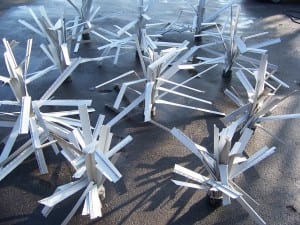HERMITAGE — With the dredging of Lake Julia just about complete and the lake bed for the most part frozen, park personnel, consultants and volunteers took to the mud and muck Saturday building and placing fish habitat structures.
Volunteers from Shenango River Watchers and Farrell Area High School; workers from dredging contractor Kirila Contractors Inc., Brookfield; park personnel; and agents of the Pennsylvania Fish and Boat Commission built and placed four kinds of structures out of rock and wood boards or posts – rock stars, spider humps, rock clusters and rock rubble humps.
While some of the structures are just piles of rocks or posts sunk into the lake bed, others are more elaborately constructed.
Spider humps are made of treated posts as a foundation, with hemlock posts secured to the treated posts, emanating outward like spider legs, and sandstone rocks piled on top.
Another kind, porcupine crib juniors – boxes built of hemlock boards arranged in the manner of Lincoln logs with gaps to allow the fish to enter – were assembled by fifth-graders from the Shenango Valley schools who participated in the last Outdoor Environmental Education Day at the park.
The structures with wood stimulate the natural food chain by giving algae something to grow on. Invertebrates will feed on the algae and fish will eat the invertebrates, said Keith Beamer, lake habitat manager for the fish commission.
“It’s sort of like a coral reef out in the ocean,” said Jeff McDowell, who works for the maintenance department of the park.
The lake was drawn down last year to improve the dam outflow structures and officials decided to have the lake dredged while the water level was reduced to that of a stream.
The process killed all the fish that lived in the lake, but park officials and the fish commission came up with a plan to restock it with bluegill, crappie, bass and catfish. Officials plan to have local Boy Scouts and Cub Scouts help with the stocking.
Posts made of alkaline copper quaternary treated wood will stick out of the surface of the water, giving anglers a guide for casting.
“The fishermen like it because they know where the fish are more likely to be,” Beamer said.
Although the wood is treated, it is not supposed to harm the lake’s water quality or any of the creatures that live in the water, Beamer said.
The boards are made of hemlock, which are expected to have a 50-year underwater life.
The restocked fish will be fingerlings, but officials are talking about putting in trout to give anglers something to cast for this year.
Park officials are not in a hurry to refill the lake as ice on the structures could damage them, but believe it will fill quickly once the outflow is closed.
“Some places, it’s going to be 18, 20 feet deep,” said Thomas W. Kuster, park board member and trustee.
Kirila workers, who used heavy equipment to dig holes for the treated posts and move around the 15 tons of rock used to build the structures, stayed on after the structures were placed to smooth out the lake bed.
“They’ve really gone the extra mile,” Kuster said of Kirila workers. “They’ve taken pride in the project.”By Joe PinchotHerald Staff Writer

